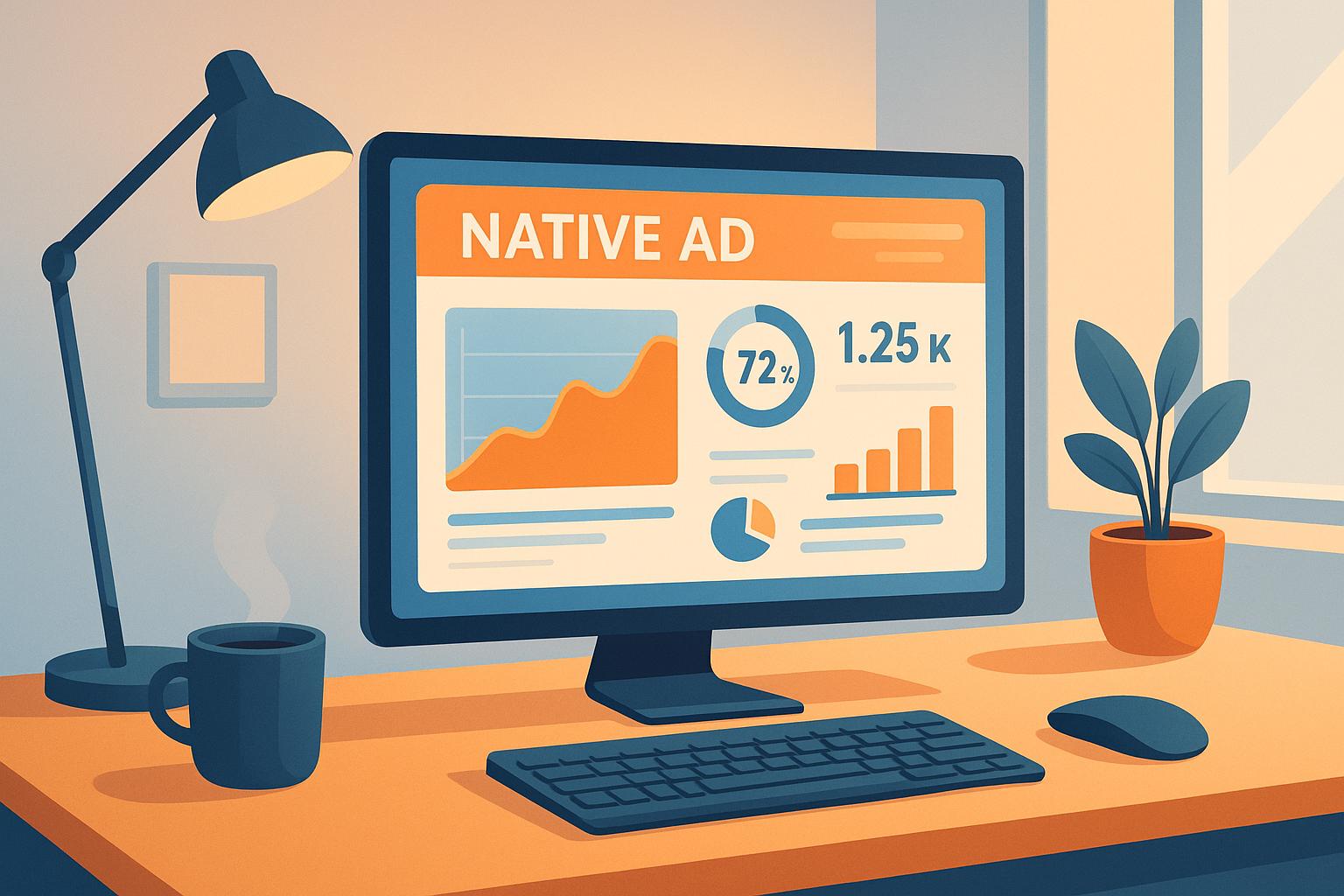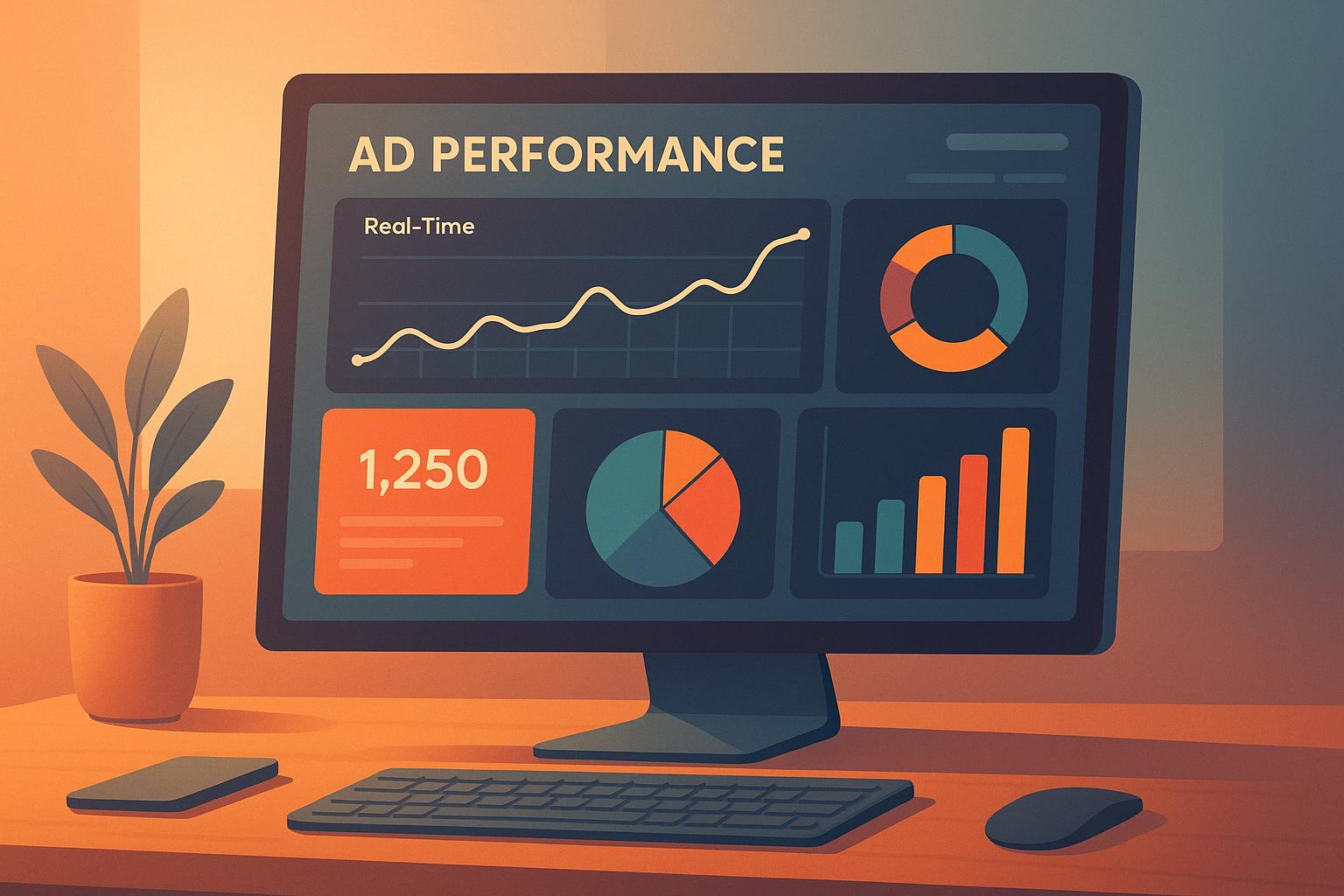


Explore best practices for real-time native ad testing, focusing on immediate feedback, brand consistency, and optimizing campaigns for developer audiences.
Real-time native ad testing is about using live data to improve ad performance instantly. Traditional testing methods often deliver delayed insights, making it hard to optimize campaigns quickly. This is especially critical for developer-focused ads, where precision and relevance matter most. Here's what you need to know:
- Why Real-Time Testing Matters: It provides immediate feedback, allowing you to adjust campaigns without waiting for outdated data. For niche audiences like developers, it ensures your ads remain relevant and effective.
- Key Challenges: Slow insights, managing multiple ad variations, and maintaining brand consistency during frequent updates can hinder ad performance.
- Solutions:
- Test one element at a time (e.g., headlines, visuals, or CTAs).
- Define clear success metrics like click-through rates (CTR) or return on ad spend (ROAS).
- Use automation tools to optimize campaigns and save time.
- Platform-Specific Benefits: Platforms like daily.dev Ads offer live performance tracking, precise audience targeting, and a trusted developer community to test campaigns effectively.
Finding and Testing Winning Native-to-Search Campaigns | Search Arb Meetup 2023
Common Problems in Native Ad Testing
Before diving into solutions, it’s important to understand the key challenges native ad testing brings to the table. Unlike traditional display ads, native ads need to seamlessly blend with surrounding content while still delivering measurable results. This balancing act introduces several hurdles that marketers must tackle to keep campaigns effective.
Slow Insights from Standard Testing Methods
One major roadblock is the sluggish pace of traditional A/B testing. These tests often demand large sample sizes and long durations to produce meaningful results. By the time insights are available, the window for timely optimization may have already closed - especially when targeting developer audiences, where trends and interests evolve rapidly.
Another drawback of standard methods is their inability to isolate the impact of individual changes. This delay in actionable insights can leave marketers scrambling to adjust their strategies. Developer communities, in particular, are quick to pivot between technologies and interests, so outdated insights can render entire campaigns irrelevant.
This slow feedback loop often traps marketers in a reactive cycle: they launch campaigns, wait for data, and then realize their messaging or creative approach missed the mark. Not only does this waste budget, but it also reduces the overall effectiveness of campaigns. These delays become even more problematic when managing multiple ad variations, where traffic distribution and clear data analysis are already challenging.
Managing Multiple Ad Variations
Testing multiple ad variations introduces its own set of challenges, particularly when dealing with niche developer audiences. Limited audience sizes and sparse traffic for each variation can stretch testing timelines even further.
Juggling different elements - like headlines, images, call-to-action buttons, and targeting parameters - requires precise traffic allocation and efficient data management. This becomes even more complex when testing across multiple placements. On top of that, ensuring all variations maintain a unified brand voice adds another layer of difficulty. Without proper oversight, the risk of inconsistencies grows as teams work through multiple iterations.
Keeping Ads On-Brand During Updates
One of the toughest aspects of optimizing native ads is maintaining brand consistency during rapid testing cycles. A consistent brand presentation across platforms can boost revenue by up to 23%, but the pressure to test and iterate quickly often leads to deviations from brand guidelines.
When teams are fragmented or lack clear oversight, inconsistencies in tone, style, or visuals can creep in. This is especially problematic because 71% of customers consider brand recognition a key factor in their purchasing decisions. Variations that stray too far from established branding can confuse audiences and erode trust - two things that are essential for native ads to succeed.
For developer audiences, who place a high value on authenticity, consistency is non-negotiable. With 47% of consumers unable to differentiate native ads from regular content, maintaining high-quality, on-brand messaging is critical. Additionally, 90% of potential customers expect a similar experience across all marketing platforms, making it even more important to uphold brand standards during fast-paced optimization efforts.
Frequent ad updates can easily jeopardize brand consistency, which risks alienating audiences - especially developers, who are quick to spot anything that feels inauthentic or disjointed.
How Real-Time Feedback Tools Transform Native Ad Testing
Real-time feedback tools are reshaping the way native ads are tested, offering instant insights that allow advertisers to make quick, data-driven decisions. By eliminating delays in data collection and addressing inefficiencies in traditional testing, these tools provide actionable intelligence while campaigns are still running.
Quick Identification of Top-Performing Ads
Using A/B testing and AI-powered analytics, advertisers can identify the most effective ad elements within hours. This approach has a measurable impact - ad optimization and testing can lead to a 53.5% increase in conversion rates. By pinpointing which variations resonate most with audiences, marketers can focus on what drives engagement.
This real-time data also supports smarter budget allocation. Instead of spreading ad spend evenly across all variations, advertisers can channel funds toward the ads that deliver the best results, maximizing return on investment.
Live Campaign Adjustments Without Stopping
Traditional testing methods often require campaigns to pause for adjustments, which can disrupt momentum. Real-time feedback tools eliminate this hurdle by enabling live updates to targeting and creative elements without interrupting the campaign. When data indicates that one variation outperforms others, the system reallocates budget dynamically based on cost-per-acquisition data.
This capability is particularly valuable for campaigns aimed at developer audiences, where engagement can shift quickly due to emerging trends or industry news. Continuous adjustments help avoid wasted ad spend and improve overall campaign performance.
Controlled Testing with Detailed Data
These tools also provide the granular insights needed for precise, controlled testing. Instead of relying on broad assumptions, advertisers gain access to analytics on essential metrics such as click-through rates, conversion rates, engagement levels, and cost per acquisition. Advanced features like heatmaps and session recordings give a deeper understanding of user behavior, offering a clear view of how audiences interact with ads.
sbb-itb-e54ba74
Best Practices for Real-Time Native Ad Testing
To make the most of real-time feedback, native ad testing requires a well-thought-out approach. By focusing on specific strategies, businesses can gain actionable insights and improve campaign performance in measurable ways.
Test One Element at a Time
Effective testing starts with isolating variables. If you change multiple elements of an ad at once, it’s nearly impossible to pinpoint what caused the improvement - or the setback.
Focus on testing one element at a time. For instance, evaluate individual components like headlines, ad copy, call-to-action buttons, visuals, formats, landing pages, targeting criteria, or offers. Use A/B testing to compare variations and clearly identify what drives better outcomes.
Once you’ve optimized individual elements, you’ll be better positioned to track and measure success accurately.
Define Clear Success Metrics
"Success metrics, often used with 'key performance indicators' (KPIs), are measurable data used to determine the achievements of your business efforts."
Before diving into testing, establish up to five specific metrics to focus your analysis. These metrics should align with your campaign goals and provide clarity on what success looks like.
"The KPIs you measure should align with your business objectives."
Use historical performance data as a baseline and research benchmarks in your industry to set realistic targets. This is especially relevant given that over 80% of digital display ads are purchased programmatically today.
Understanding key metrics like ROI (return on investment) and ROAS (return on ad spend) is essential. While ROI evaluates the return from your overall investment, ROAS focuses on the results of individual campaigns. Knowing the difference can help you interpret testing results more effectively.
Transparent reporting ensures that insights from your testing efforts lead to actionable changes. Keep refining and testing to progressively improve your ad performance over time.
Once you’ve defined your metrics, automation becomes a powerful tool for scaling your efforts.
Use Automation for Campaign Optimization
Automation transforms the testing process, making it faster and more efficient. AI-powered tools can take over tasks like setting budgets, optimizing bids, and identifying high-performing variations.
The benefits of automated optimization are clear. For example, testing and refining ad variations can boost conversion rates by 53.5%. Tools like Adalysis reduce account maintenance time by as much as 97%, allowing marketers to focus on strategy rather than repetitive tasks.
"The best ad testing technology doesn't just give you more data - it gives you better decisions. At Social Firm, we look for tools that translate complex testing results into clear, strategic recommendations our clients can immediately implement to better connect with their target audience." - Laura Elliott, Senior Digital Strategist, Social Firm
AI-powered tools excel at identifying patterns and correlations that manual testing might miss. They also allow brands to test hundreds of creative variations simultaneously - something traditional A/B testing struggles to manage. A survey revealed that 70% of respondents believe AI tools will help them achieve their goals, with 69% planning to use AI to assign creative quality scores to ads before launch.
Automation also simplifies the creation of scalable ad campaigns across multiple platforms, ensuring consistency while testing variations for different audience segments or geographic regions. By using the right technology, you can turn complex data into actionable strategies that deliver results.
How daily.dev Ads Supports Real-Time Native Ad Testing

daily.dev Ads builds on established real-time testing methods, offering tools tailored specifically for developer-focused businesses. Positioned within the developer community, the platform provides an ideal setting for testing and refining campaigns aimed at technical audiences. Let’s dive into how live tracking, precise targeting, and community engagement make this platform stand out.
Live Performance Tracking and Data
Advertisers on daily.dev Ads can access a live dashboard to track key metrics like impressions, clicks, click-through rates (CTR), and engagement in real time. This instant access to performance data enables businesses to quickly identify which ads are working and make immediate adjustments to improve outcomes.
Here’s an example: A SaaS company targeting Python developers tested multiple ad variations on daily.dev. Real-time data revealed that ads featuring code snippets significantly outperformed those with generic images. By reallocating the budget to the higher-performing ads, the company increased their CTR by 30% in just one week.
The platform also provides interactive visuals to help advertisers spot trends, analyze audience behavior, and compare ad performance. These visualizations make it easier to identify underperforming elements and share results with stakeholders. For instance, if an advertiser notices a surge in engagement shortly after launching a new creative, they can adjust their strategy on the fly. These real-time insights are invaluable for fine-tuning campaigns and targeting audiences more effectively.
Advanced Targeting for Developer Audiences
daily.dev Ads offers granular targeting options, allowing advertisers to reach audiences based on programming languages, developer seniority (junior, mid-level, or senior engineers), preferred tools, and geographic location. This level of detail ensures that ads are shown to the most relevant users, increasing the chances of engagement and conversions.
For example, a company promoting a new JavaScript framework can target developers specifically interested in JavaScript and related technologies. This approach goes beyond basic demographic targeting, honing in on the technical skills and interests that matter most to developer-focused businesses.
The platform also supports hyper-local and technology-specific segmentation, enabling businesses to test different messaging strategies for distinct developer communities. This specificity ensures that performance metrics reflect genuine interest from the intended audience rather than broad, unfocused engagement. By combining precise targeting with a trusted developer community, advertisers can generate more meaningful results.
Trusted Developer Community for High Engagement
daily.dev is a platform developers trust for relevant, high-quality content. Ads are seamlessly integrated into the user experience, making them feel like a natural part of the platform rather than intrusive interruptions. This trust leads to higher engagement rates and improves brand perception for advertisers.
The platform enforces strict content guidelines and reviews all ad creatives to ensure they align with both the advertiser’s goals and the expectations of the developer audience. Advertisers can also preview how their ads will appear in different placements, ensuring a consistent and relevant experience throughout their campaigns.
This trusted environment creates ideal conditions for ad testing. Developers are more likely to engage authentically with ads that feel relevant and non-disruptive. Plus, the technical expertise of the community ensures that engagement metrics provide meaningful insights for businesses developing products or services for developers.
daily.dev Ads also automates bid adjustments and budget allocation, allowing businesses to focus on refining their strategies. By combining real-time insights with automated tools, the platform simplifies the testing process, helping advertisers optimize their campaigns with ease.
Key Takeaways for Real-Time Native Ad Testing
Real-time native ad testing offers instant insights and enables on-the-fly adjustments, which are essential for staying competitive in today’s fast-moving digital world.
Using data-driven strategies can significantly improve campaign outcomes. For instance, studies have shown that focusing on data rather than intuition can lead to conversion rate increases of up to 53.5%. This highlights how crucial it is to make informed decisions when allocating budgets.
Three key practices form the foundation of successful real-time testing: breaking down and testing individual ad elements, setting clear and measurable success metrics, and utilizing automation to streamline and scale the process. These steps are particularly important for campaigns targeting niche audiences, such as developers.
For developer-specific campaigns, platforms like daily.dev Ads provide tools tailored to this audience. Features include live performance tracking, advanced targeting based on programming expertise and seniority, and access to a trusted developer community. By delivering relevant ads in a reliable environment, these platforms generate performance metrics that can be directly applied to refine and improve campaigns.
Shifting from traditional testing methods to real-time feedback marks a major evolution in campaign optimization. With real-time tracking and audience insights, advertisers can make immediate adjustments, ensuring their campaigns consistently perform at their best.
FAQs
How can real-time testing improve the performance of native ads targeting developers?
Real-time testing gives you the power to evaluate how your native ads are doing on the fly, letting you make quick adjustments to boost performance. When it comes to campaigns aimed at developers, this flexibility allows you to tweak elements like messaging, visuals, and placements to better match their specific preferences and habits.
Using real-time feedback, you can adjust your ads to drive stronger engagement, sharpen targeting, and improve the overall success of your campaign. This method helps ensure your ads connect with a focused audience like developers, making them more impactful and effective.
What are the biggest challenges of testing multiple native ad variations in real time, and how can they be addressed?
Managing multiple native ad variations in real time isn’t exactly a walk in the park. You’ve got to deal with things like uneven budget distribution, inconsistent performance data, and testing results that don’t always add up. If these issues aren’t addressed properly, you could end up wasting money and getting results that leave you scratching your head.
One way to tackle these challenges is by leveraging AI-powered automation. It can simplify the process of creating, testing, and analyzing your ads, saving you time and effort. Another key strategy? Focus on small, incremental changes - often called micro-iterations. By setting clear goals for your tests and refining your approach step by step, you’ll not only get more reliable results but also connect more effectively with your audience.
Why is it important to maintain brand consistency during fast-paced ad testing, and how can advertisers achieve it?
Maintaining brand consistency during rapid ad testing is key to building trust, cultivating audience loyalty, and reinforcing brand identity. Each ad should seamlessly reflect your brand, ensuring your message connects with your audience while solidifying who you are.
Here are some ways to keep your brand consistent:
- Stick to the same visual elements - like logos, colors, and fonts - across all ads.
- Keep your messaging aligned with your brand’s tone and core values.
- Regularly review and audit your ad creatives to ensure they follow your brand guidelines.
By prioritizing consistency, your brand stays recognizable and credible, even in the fast-moving world of real-time ad testing.






